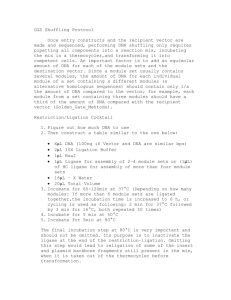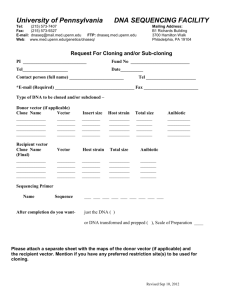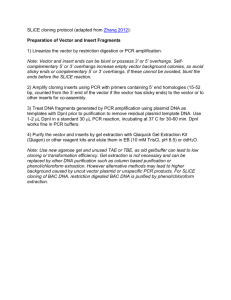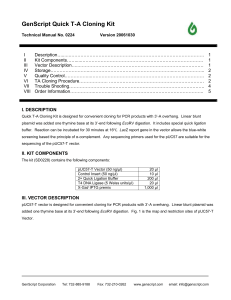General cloning tips
advertisement
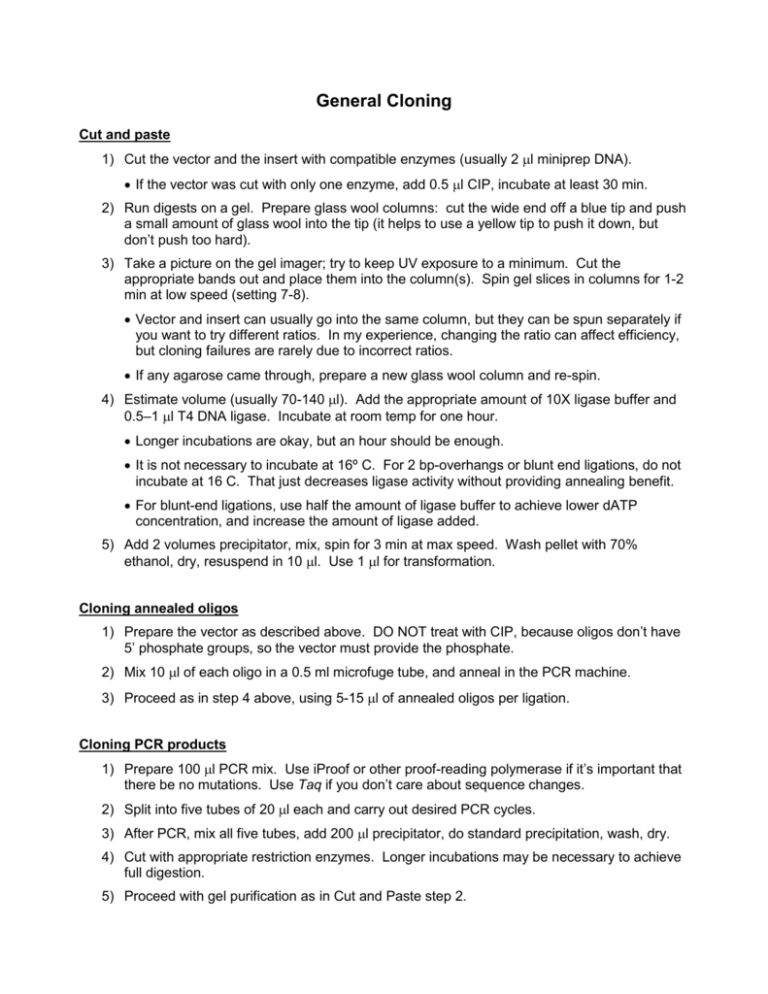
General Cloning Cut and paste 1) Cut the vector and the insert with compatible enzymes (usually 2 l miniprep DNA). If the vector was cut with only one enzyme, add 0.5 l CIP, incubate at least 30 min. 2) Run digests on a gel. Prepare glass wool columns: cut the wide end off a blue tip and push a small amount of glass wool into the tip (it helps to use a yellow tip to push it down, but don’t push too hard). 3) Take a picture on the gel imager; try to keep UV exposure to a minimum. Cut the appropriate bands out and place them into the column(s). Spin gel slices in columns for 1-2 min at low speed (setting 7-8). Vector and insert can usually go into the same column, but they can be spun separately if you want to try different ratios. In my experience, changing the ratio can affect efficiency, but cloning failures are rarely due to incorrect ratios. If any agarose came through, prepare a new glass wool column and re-spin. 4) Estimate volume (usually 70-140 l). Add the appropriate amount of 10X ligase buffer and 0.5–1 l T4 DNA ligase. Incubate at room temp for one hour. Longer incubations are okay, but an hour should be enough. It is not necessary to incubate at 16º C. For 2 bp-overhangs or blunt end ligations, do not incubate at 16 C. That just decreases ligase activity without providing annealing benefit. For blunt-end ligations, use half the amount of ligase buffer to achieve lower dATP concentration, and increase the amount of ligase added. 5) Add 2 volumes precipitator, mix, spin for 3 min at max speed. Wash pellet with 70% ethanol, dry, resuspend in 10 l. Use 1 l for transformation. Cloning annealed oligos 1) Prepare the vector as described above. DO NOT treat with CIP, because oligos don’t have 5’ phosphate groups, so the vector must provide the phosphate. 2) Mix 10 l of each oligo in a 0.5 ml microfuge tube, and anneal in the PCR machine. 3) Proceed as in step 4 above, using 5-15 l of annealed oligos per ligation. Cloning PCR products 1) Prepare 100 l PCR mix. Use iProof or other proof-reading polymerase if it’s important that there be no mutations. Use Taq if you don’t care about sequence changes. 2) Split into five tubes of 20 l each and carry out desired PCR cycles. 3) After PCR, mix all five tubes, add 200 l precipitator, do standard precipitation, wash, dry. 4) Cut with appropriate restriction enzymes. Longer incubations may be necessary to achieve full digestion. 5) Proceed with gel purification as in Cut and Paste step 2. Troubleshooting Cloning Saying that cloning “didn’t work” is not very informative. If you try to understand why it failed, you’ll have better luck trying to fix it. Too many colonies If the plasmids look like the vector alone, it’s likely that the vector didn’t cut to completion. When sites are near one another, single-cut vector can’t be separated from double-cut vector. Single-cut vector re-ligates as an intra-molecular reaction, which is much more efficient than inter-molecular reactions. Therefore, a small amount of single-cut vector can “out-compete” the desired ligation product. You can confirm this by doing a control ligation with no insert – if you get lots of colonies, you have a problem cutting the vector. Possible remedies: Treat with CIP, even if you’re cutting with two enzymes. Determine whether each enzyme can cut individually, in the buffer you are using. If cutting is poor, change buffers or increase digestion time. If both cut well, make sure the sites aren’t too close together so that once one enzyme cuts the other site is too near the end of the fragment. Sequential digestions can help in some cases. Digest the ligation products with an enzyme that will cut the original vector but not the desired product (linear DNA does not transform well). Sometimes you can find a site that is between the sites being used for cloning and that is not in the insert. Some enzymes will cut in ligase buffer (you may need to adjust salt). Otherwise, precipitate and resuspend in digestion buffer, digest, then precipitate again before transformation. If the colonies do not look like the initial vector, see the next section. Space DNA If miniprep DNA from colonies obtained after cloning is unrecognizable, there is contamination from some random vector. This could come from something used before digestion, but since cutting out a band will eliminate all contaminating DNA that is not the same size, it seems more likely that the contamination point comes after the gel. Possible sources include the glass wool, plasticware, your water or TE, ligase buffer, ligase, cuvettes, etc. Replace as many of these as you can. Unfortunately, some space DNA is persistent – we’ve never figured out where it comes from or why it goes away. No/few colonies

